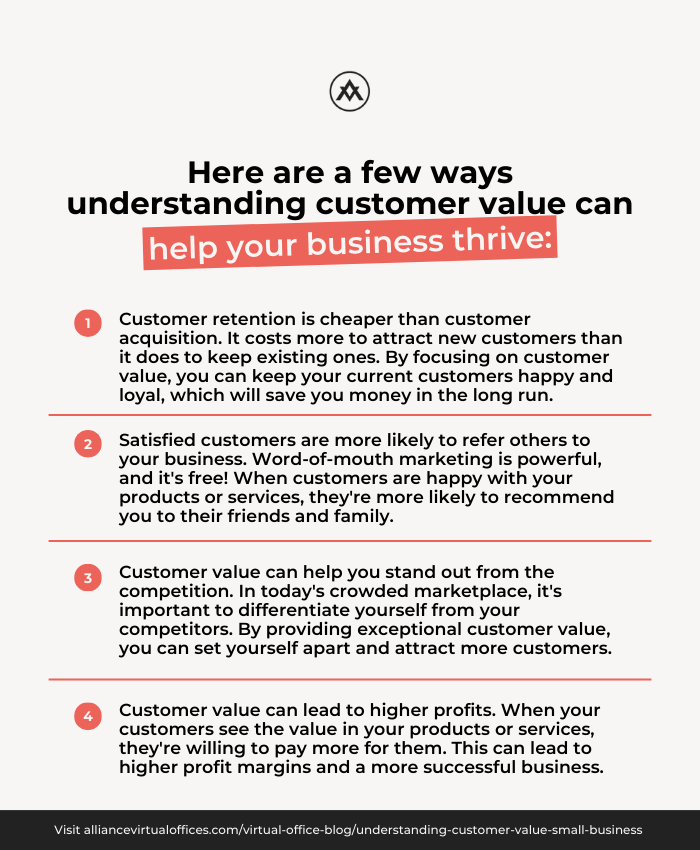- Defining customer value
- Strategies for increasing customer value
- Building a customer-centric business culture
Q: How can small businesses effectively measure the impact of their customer value enhancement strategies?
A: Small businesses can effectively measure the impact of their customer value enhancement strategies by tracking key performance indicators such as customer satisfaction scores, retention rates, and repeat purchase rates. This article explains the concept of customer value and provides practical strategies you can use to increase your profits.
As a small business owner, understanding and maximizing customer value is key to your business’s success.
In this article, we delve into the significance of customer value and how it can be a game-changer for your bottom line.
You’ll uncover the essentials of customer value and practical tactics to boost it, ensuring that your business not only survives but excels in today’s competitive landscape.
Defining Customer Value
As a business owner, you know that your customers are the lifeblood of your company. But how do you define customer value?
Customer value can be defined as the perceived benefits a customer receives from a product or service compared to the cost of acquiring and using it.
To understand customer value, you must first understand your customers’ needs and wants. By identifying what your customers value, you can tailor your products or services to meet those needs and create a competitive advantage in the marketplace.
There are many factors that contribute to customer value, including product quality, customer service, price, convenience, and reputation.
By providing high-quality products and excellent customer service, you can increase the perceived value of your products and services and build customer loyalty.
It’s important to remember that customer value is not a one-time event.
As customer needs and wants evolve, so must your products and services.
By constantly monitoring and adapting to changes in the marketplace, you can ensure that your customers continue to receive value from your products and services.
Defining customer value is essential to the success of any business. By understanding what your customers value and delivering high-quality products and services, you can build customer loyalty and create a competitive advantage in the marketplace.
The Importance of Customer Value in Small Businesses
As a small business owner, you know how important it is to attract and retain customers. But have you considered the value that each customer brings to your business? Customer value is a crucial aspect of any successful business, and it’s especially important for small businesses looking to grow and thrive.
To provide the best customer value, you need to understand your customers’ needs and preferences. This means listening to their feedback, offering personalized solutions, and providing exceptional customer service.
Strategies for Increasing Customer Value
Personalizing Customer Experiences
One of the most effective ways to increase customer value is by personalizing their experiences with your brand. You can achieve this by collecting data on their preferences, behaviors, and needs.
Use this data to tailor your marketing campaigns, product recommendations, and customer service interactions. This will make your customers feel valued and understood, leading to increased loyalty and higher lifetime value.
Measuring and Analyzing Customer Value
To increase customer value, it’s important to understand how much value each customer brings to your business.
Use metrics such as customer lifetime value, customer acquisition cost, and retention rate to measure and analyze customer value. This will help you identify which customers are the most valuable to your business and which strategies are most effective in increasing their value.
Targeting and Retaining Loyal Customers
Retaining loyal customers is crucial for increasing customer value. To do this, you need to identify your most loyal customers and create strategies to keep them engaged with your brand.
Offer exclusive rewards, personalized experiences, and exceptional customer service to keep them coming back. Additionally, target your marketing efforts towards your most loyal customers to encourage them to make repeat purchases and refer your brand to others.
Applying Customer Value Concepts in Daily Operations
To increase customer value, it’s important to integrate customer value concepts into your daily operations. Encourage all employees to prioritize customer satisfaction and provide exceptional customer service.
Additionally, use data and analytics to inform decision-making and optimize processes to better serve your customers.
Evaluating the Impact of Customer Value Strategies
To ensure that your customer value strategies are effective, it’s important to regularly evaluate their impact. Use metrics such as customer satisfaction, retention rate, and revenue growth to measure the success of your strategies.
Use this information to make data-driven decisions and continuously improve your customer value strategies.
By implementing these strategies, you can increase customer value and drive growth for your business.
Personalize customer experiences, measure and analyze customer value, target and retain loyal customers, apply customer value concepts in daily operations, and evaluate the impact of your strategies to achieve success.
Case Studies: Success Stories in Enhancing Customer Value
When it comes to enhancing customer value, there are numerous success stories of companies that have achieved this feat. Here are a few examples:
- Amazon: Amazon has been able to enhance customer value by offering fast and reliable shipping, a wide range of products, and excellent customer service. They have also implemented a personalized recommendation system that suggests products based on a customer’s browsing and purchase history.
- Zappos: Zappos is known for its exceptional customer service. They have a customer-centric culture that focuses on providing the best possible experience for their customers. They offer free shipping and returns, a 365-day return policy, and a 24/7 customer service team.
- Apple: Apple has been able to enhance customer value by creating products that are easy to use and aesthetically pleasing. They have also implemented a customer loyalty program that rewards customers for their continued business.
- Southwest Airlines: Southwest Airlines has enhanced customer value by offering low fares, no baggage fees, and a customer-friendly cancellation policy. Their fun and friendly culture makes flying with them an enjoyable experience.
- Starbucks: Starbucks has been able to enhance customer value by creating a welcoming atmosphere in their stores, offering high-quality coffee and food products, and implementing a customer loyalty program that rewards customers for continued purchases.
These companies have enhanced customer value by focusing on their customers’ needs and wants and implementing strategies to improve customer experience.
By doing so, they have been able to build strong relationships with their customers and create a loyal customer base.
Leveraging Customer Feedback for Continuous Improvement
As a business owner, you know the importance of customer feedback. Feedback is a valuable tool that can help you improve your products and services.
By listening to your customers, you can identify areas for improvement and make changes to meet their needs.
Creating a feedback loop is one way to leverage customer feedback for continuous improvement; this means collecting customer feedback, analyzing it, and then making data-based changes.
By doing this, you show your customers that you value their opinions and are committed to providing them with the best possible experience.
Another way to leverage customer feedback is to use it to identify trends.
By analyzing feedback from multiple customers, you can identify common themes and areas where you need to focus your attention. For example, if multiple customers are complaining about the same issue, you know that it’s a problem that needs to be addressed.
You can also use customer feedback to identify areas of opportunity. By listening to your customers, you may discover that there is a need for a new product or service that you can offer. By responding to this need, you can increase customer satisfaction and grow your business.
Leveraging customer feedback for continuous improvement is essential for any business that wants to succeed.
Integrating Market Analysis for Business Strategy
To create customer value, it’s essential to understand the market and how your business fits into it.
A thorough market analysis can help you identify opportunities and challenges and develop a strategy that aligns with your customers’ needs. Here are some ways to integrate market analysis into your business strategy:
- Identify your target market: Who are your customers? What are their needs and preferences? Conduct surveys, focus groups, and other research to gain insights into your target market. Use this information to develop products and services that meet their needs.
- Analyze your competitors: Who are your main competitors? What are their strengths and weaknesses? Analyze their marketing strategies, pricing, and product offerings to identify areas where you can differentiate yourself.
- Monitor industry trends: What are the latest trends in your industry? How can you leverage these trends to create value for your customers? Stay up-to-date on industry news, attend conferences and trade shows, and network with other professionals to stay informed.
- Develop a SWOT analysis: Conduct a SWOT (Strengths, Weaknesses, Opportunities, Threats) analysis to identify internal and external factors that can impact your business. Use this analysis to develop a strategy that leverages your strengths, addresses your weaknesses, capitalizes on opportunities, and mitigates threats.
By integrating market analysis into your business strategy, you can create customer value by developing products and services that meet their needs, differentiating yourself from competitors, and staying ahead of industry trends.
Building a Customer-Centric Business Culture
To build a customer-centric business culture, you need to focus on creating a culture that values customers and their needs. Here are some steps to help you achieve this:
- Start with your employees: Your employees are the face of your business, and you need to ensure that they understand the importance of customer satisfaction. Train them to be empathetic, patient, and attentive to customers’ needs.
- Listen to your customers: To understand your customers’ needs, you need to listen to them. Encourage feedback and provide multiple channels for customers to reach out to you, such as social media, email, phone, or in-person.
- Make customer satisfaction a priority: Make sure that customer satisfaction is a top priority for your business. This means you need to measure and track customer satisfaction metrics, such as Net Promoter Score (NPS), customer retention rate, and lifetime value (CLV).
- Empower your employees: Empower your employees to make decisions that benefit the customers. This means giving them the tools, resources, and authority to resolve customer issues, make exceptions, and go the extra mile.
- Reward customer-centric behavior: Reward employees who exhibit customer-centric behavior, such as going above and beyond to help customers, resolving issues quickly and efficiently, and providing exceptional service.
By building a customer-centric business culture, you can create a loyal customer base that will help grow your business and improve your bottom line.
Wrapping Up: Customer Value
In this article, we’ve navigated through the vital aspects of customer value, from its definition to actionable strategies for its improvement. Now, it’s time for you to apply these insights.
Want to improve your customer value while saving time and money? A Live Receptionist from Alliance Virtual Offices can help.
Further Reading
- Unlocking Sustainable Growth: How Sustainable Practices Propel Small Businesses Forward
- Unlocking the Power of Content Marketing: A Strategic Guide for Business Growth
- Blueprint to Success: Crafting Your Comprehensive Business Plan
- The Customer Connection: Is a Live Receptionist Your Key to Success?
With a Live Receptionist, your business gains a professional, friendly receptionist who will answer all incoming calls on your behalf.
Your Live Receptionist helps you build and maintain strong customer relationships and personalize their interactions with your business, helping you increase the value of your customers and grow your business.



